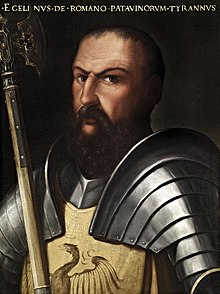Ezzelino da Romano
Ezzelino III. da Romano ( German Ezzelin , born April 25, 1194 in Onara near Padua ; † September / October 1259 in Soncino near Cremona ) was a Ghibelline feudal lord in the Treviso region . He had a reputation for extraordinary cruelty.
Life
He was the son of Ezzelino II da Romano († 1235), lord of Bassano , and Adelheid von Alberti di Mangona , who came from a Tuscan count family. He had inherited land in Treviso from his father . In the conflict at that time between Staufer Friedrich II. With the Pope and various Lombard cities (the Guelph party ), Ezzelino stood on the side of the emperor (the Ghibelline party ). In 1236 he took control of Verona and soon ruled Vicenza as Signore . By 1241 Padua, Belluno , Feltre , Trient and the Treviso region were added. On May 23, 1238 he married Frederick II's illegitimate daughter Selvaggia († 1244) in Verona. Several times he supported the emperor with troops, while Frederick II accepted the largely autonomous rule of Ezzelino in return. He ruled his territories without interfering too much in the internal affairs of the communes. Contemporary sources describe drastically how he persecuted his opponents with great cruelty. Like Frederick II, he was banned by the Pope in 1248. Even after the emperor's death at the end of 1250, Ezzelino was able to assert himself and continued the fight against the pope with other Ghibellines. Pope Innocent IV finally called for a crusade against Ezzelino and his allies; In 1256 the enemy troops succeeded in conquering Padua. Nevertheless, Ezzelino did not give up. In 1258 he even conquered Brescia . In a direct attack against Milan he was defeated on September 27, 1259 in the Battle of Cassano d'Adda near Soncino , during which he was injured by an arrow. While on the run, he was captured near Bergamo . The exact circumstances of his death are in the dark.
Aftermath
Much of what we learn about Ezzelino comes from a literary tradition that has spread over the centuries. He became the basic type of cruel tyrant. Poets and chroniclers close to him used his name to evoke an impression of the arbitrary use of force and moral depravity. In the 14th century he was even accused of being of demonic origin.
Together with Obizio von Este, Dante names him as a tyrant devoted to property and blood in his Divine Comedy :
The black-haired forehead can be seen next to them,
Den Ezzelin - and that blonde there,
Is Obiz Este, who, as it has been clearly shown.
As a figure he can be found in the following works:
- Albertino Mussato : Ecerinis, around 1315
- Joseph von Eichendorff : Ezelin von Romanis, 1828
- Carlo Marenco : Ezzelino III, 1832
- Conrad Ferdinand Meyer : The wedding of the monk, novella 1884
- Carl Friedrich Lessing : Ezzelino da Romano in the dungeon, painting 1838, Städel Museum, Frankfurt
- Hermann von Lingg: Friedrich and Ezelin (ballad)
literature
- Ezzelino III da Romano. In: Enciclopedie on line. Istituto della Enciclopedia Italiana, Rome. Retrieved September 1, 2016.
- SSante Bortolami: Ezzelino III da Romano. In: Maria Paola Arena (ed.): Enciclopedia fridericiana. Volume 1: A – H, Rome 2005.
- Gina Fasoli : Ezzelino III. da Romano, Signor from Northern Italy (1194–1259). In: Lexicon of the Middle Ages . Volume 4: Arch Chancellor to Hiddensee. Artemis-Verlag, Munich et al. 1989, ISBN 3-7608-8904-2 , Sp. 196-197.
- Gina Fasoli: Ezzelino da Romano fra tradizione cronachistica e revisione storiografica. In: Storia e cultura a Padova nell'età di sant'Antonio (= Fonti e Ricerche di Storia Ecclesiastica Padovana. 16, ZDB -ID 280722-1 ). Istituto per la Storia Ecclesiastica Padovana, Padua 1985, pp. 85-101.
- Mario Rapisarda: La signoria di Ezzelino da Romano. Del Bianco, Udine 1965.
-
Wolfgang Stürner : Friedrich II. 2 volumes. Scientific Book Society, Darmstadt 1992–2000;
- Volume 1: The royal rule in Sicily and Germany 1194–1220. 1992, ISBN 3-534-04136-4 ;
- Volume 2: The Emperor 1220-1250. 2000, ISBN 3-89678-025-5 .
Web links
Individual evidence
- ^ After Volker Reinhardt : The Renaissance in Italy. History and culture (= Beck'sche Reihe. 2191 C.-H.-Beck-Wissen ). CH Beck, Munich 2002, ISBN 3-406-47991-X , p. 45, as “quasi-signory”, since according to Reinhardt, rule does not yet represent a signory in formal legal terms. Reinhardt sees the first formal legal signature realized by the Este family in Ferrara in 1264.
- ↑ Dante: Divine Comedy, Hell, Canto 12, verses 104–117. In the original: E quella fronte c 'ha' l pel così nero, è Azzolino; e quell'altro ch'è biondo, è Opizzo da Esti, il qual per vero.
| personal data | |
|---|---|
| SURNAME | Ezzelino da Romano |
| ALTERNATIVE NAMES | Ezzelino III. da Romano |
| BRIEF DESCRIPTION | Italian prince |
| DATE OF BIRTH | April 25, 1194 |
| PLACE OF BIRTH | Onara near Padua , Italy |
| DATE OF DEATH | between September 1259 and October 1259 |
| Place of death | Soncino near Cremona |
